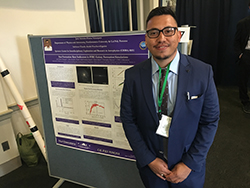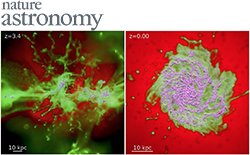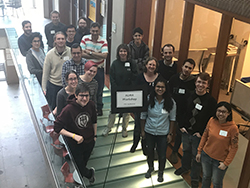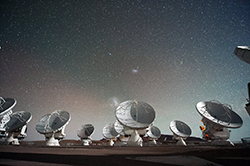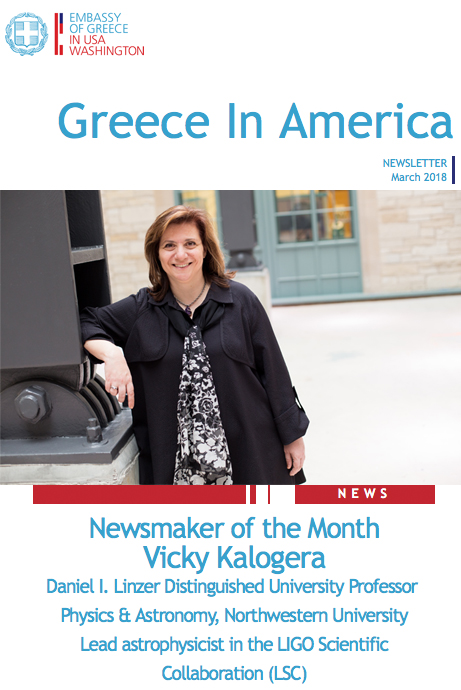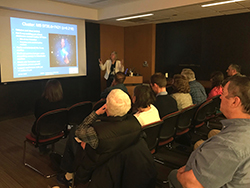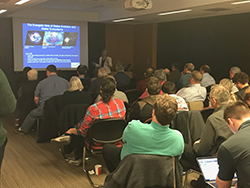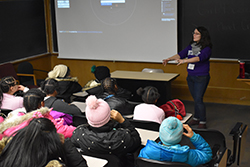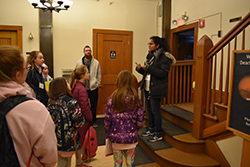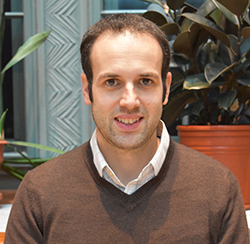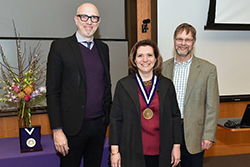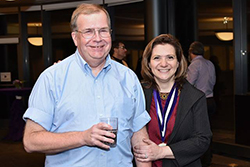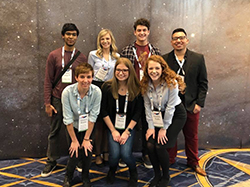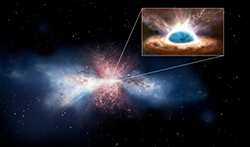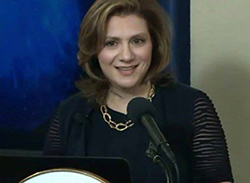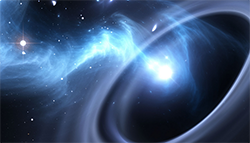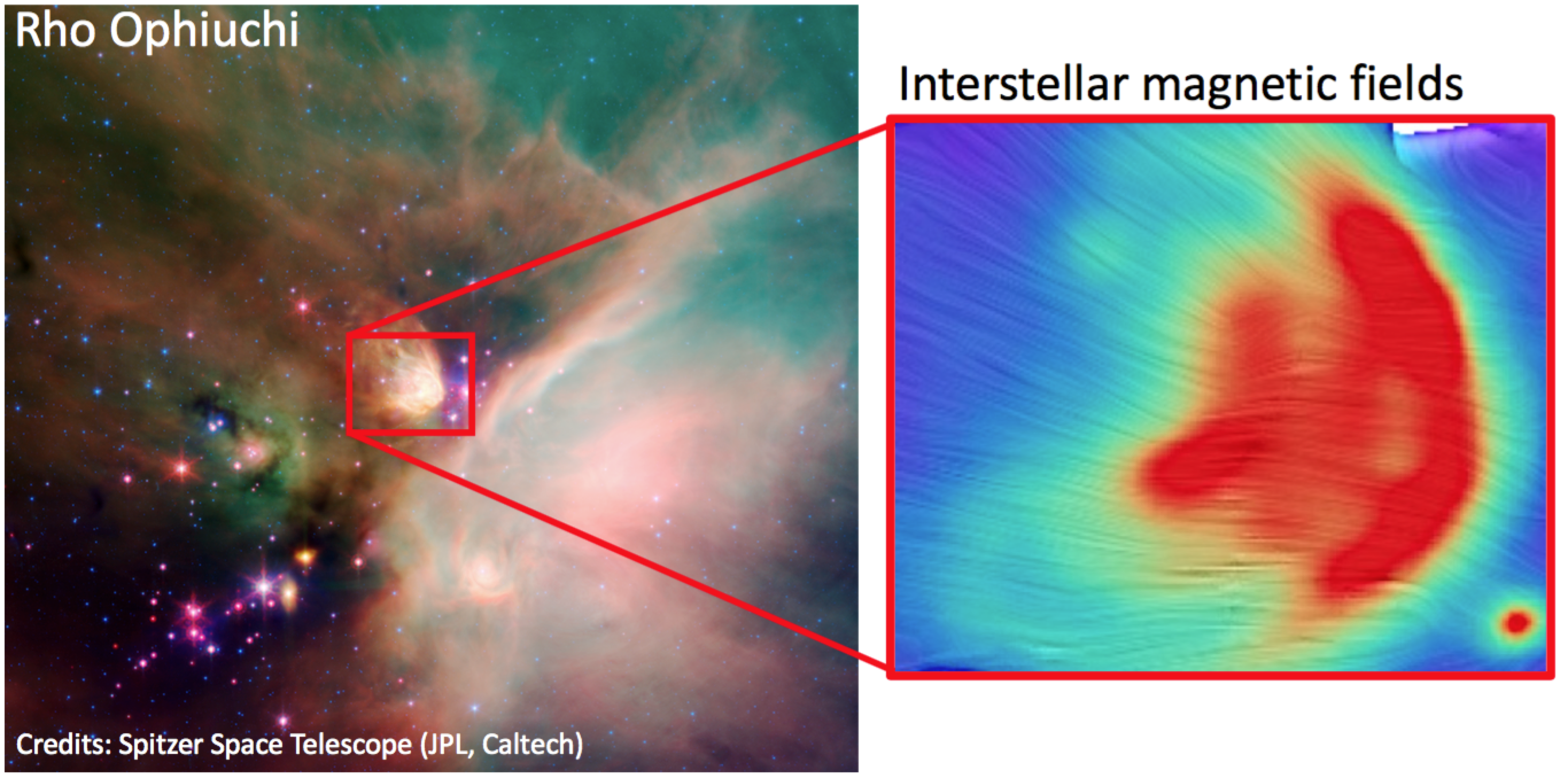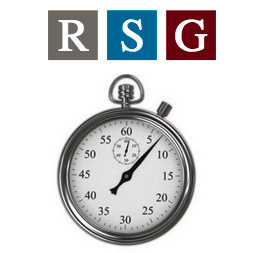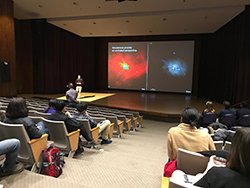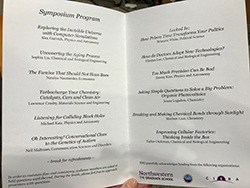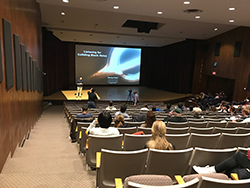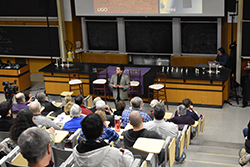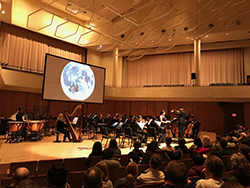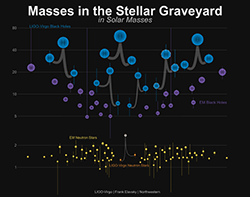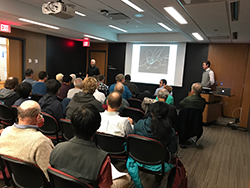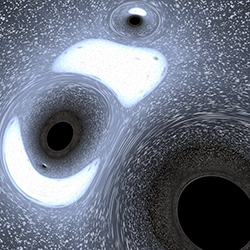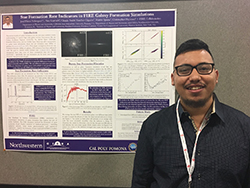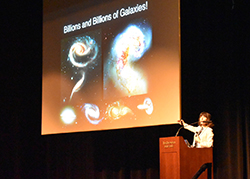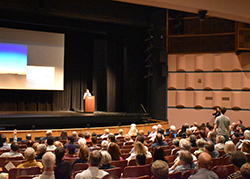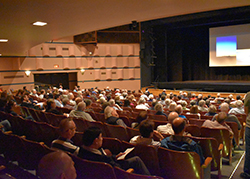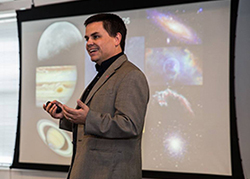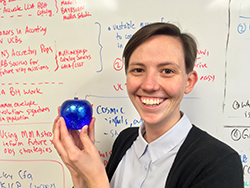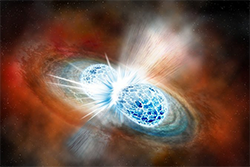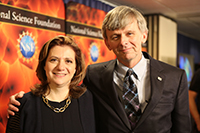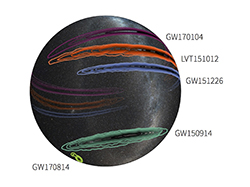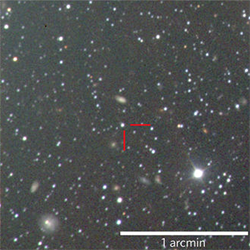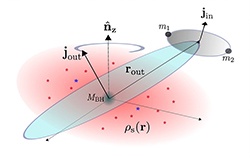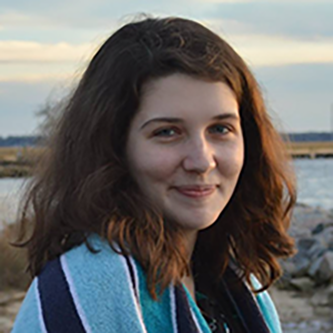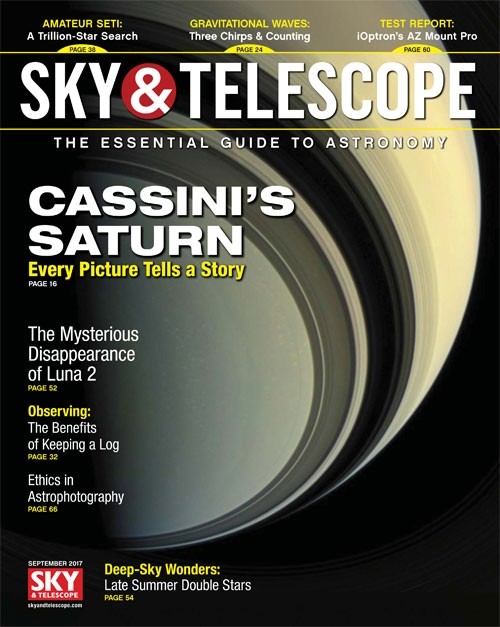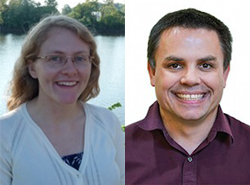July 2018
| |||||||||||||||
|
"Astronomers using telescopes across the electromagnetic spectrum and the Atacama Large Millimeter Array (ALMA) studied a cataclysmic stellar explosion known as a gamma-ray burst, or GRB, and found its enduring afterglow. The rebound, or reverse shock, triggered by the GRBs powerful outflows slamming into surrounding debris, lasted thousands of times longer than expected. These observations provide fresh insights into the physics of GRBs, one of the universes most energetic explosions.... These observations enabled a team of astronomers, including Northwestern University astrophysicists Wen-fai Fong and Raffaella Margutti, to produce ALMA’s first-ever time-lapse movie of a cosmic explosion. The study, led by Tanmoy Laskar, a Jansky Postdoctoral Fellow of the National Radio Astronomy Observatory (NRAO), appears today, July 26, in the Astrophysical Journal." Read the full Northwestern Now article. |
|||||||||||||||
|
The 12th International LISA Symposium was held in Chicago July 8 - 13. The meeting was dedicated to gravitational wave astrophysics, with particular emphasis on sources that can be observed in the millihertz band by the Laser Interferometer Space Antenna (LISA), the current status and unique challenges in gravitational theory and analysis for LISA sources, and the latest updates on the development of the LISA mission. The Symposium was hosted by CIERA and co-sponsored by the American Astronomical Society, with CIERA professors Shane Larson and Fred Rasio leading the scientific organizing committee. About 240 people participated, including Northwestern researchers Katie Breivik, Eve Chase, Vicky Kalogera, Michael Katz, Kyle Kremer, Shane Larson, and Fred Rasio. Learn more about the LISA space mission. |
|||||||||||||||
|
About 25 members of GWIC, the Gravitational Wave International Committee, met on July 8 at the start of the 12th International LISA Symposium. Formed over 20 years ago, the committee facilitates international collaboration and cooperation in the construction, operation and use of the major gravitational wave detection facilities world-wide. CIERA Director Vicky Kalogera helped host and organize, and CIERA sponsored the meeting. Learn more about GWIC and gravitational waves. |
|||||||||||||||
June 2018
| |||||||||||||||
|
MODEST-18, the 18th workshop on Modeling and Observing DEnse STellar systems, took place on the island of Santorini, Greece, June 25 - 29. Scientific sessions were held at the Petros Nomikos Conference Centre located in the capital city of Firá. About 100 international participants attended, presenting 65 talks and 35 posters. CIERAs Fred Rasio and UCLAs Andrea Ghez led the scientific organizing committee, and Vicky Kalogera, a native of Greece, led the local organizing committee. CIERA researchers Katie Breivik, Kyle Kremer, Newlin Weatherford, Claire Ye, and Mike Zevin, along with CIERA alums Sourav Chatterjee and Carl Rodriguez all presented research. Visit the MODEST-18 web site. |
|||||||||||||||
|
On Saturday, June 16th, over 170 middle and high school girls from around the United States gathered to address the future of diversity in STEM during GirlCon 2018, hosted by CIERA and Reach for the Stars. GirlCon was held at Northwesterns Norris Center and was ideated, organized, and executed by a team of 15 high-school girls from across the US, lead by Deerfield High School rising junior Kyla Guru and Libertyville High School rising senior Molly Graton. More than 50 recognized experts in the fields of Science, Technology, Engineering and Mathematics served as speakers, breakout session leaders, and lunch panelists. Learn more about GirlCon at girlcon.io and follow @girlconchicago on Instagram for updates about 2019! |
|||||||||||||||
|
Ben Nelson has accepted an Insight Data Science Fellowship in Silicon Valley. Insight is an intensive, seven week postdoctoral training fellowship that bridges the gap between academia and a career in data science and enables scientists to learn the industry specific skills needed to work in the growing field of big data at leading companies. Mentor/hiring companies involved in the Silicon Valley program include: Facebook, LinkedIn, Twitter, Airbnb, Uber, Microsoft, Apple, Netflix, Stitch Fix, Square and many high growth startups. Fabio Pereira Santos has moved to a post-doctoral position at the Max Planck Institute for Astronomy (MPIA) in Heidelberg, Germany. In addition to independent research, Fabio will help with the commissioning of LINC-NIRVANA (LN), a near-infrared imaging instrument for the Large Binocular Telescope (LBT) that will offer very high angular resolution to explore our Galaxy and beyond. Alexander Richings will be leaving CIERA to start a Junior Research Fellowship at the Institute for Computational Cosmology (ICC) at Durham University in the UK. He will be continuing his research into the role of interstellar chemistry in galaxy formation, using hydrodynamic simulations. |
|||||||||||||||
|
On June 4, Professor Brice Ménard from Johns Hopkins University presented How Do You Want Your Data: Hot or Cold? to an audience of about 70. Ménard posited that, as time goes on, our interaction with large datasets tends to be more involved and less intuitive. Most datasets can no longer be visualized in their entirety and we have to interact with them mathematically, making blind data exploration challenging. In his talk, Ménard presented some theoretical considerations of data analysis and data complexity, and showed that performing a "cooling" operation on data can automatically reveal the inherent structure of a dataset and the properties of its underlying population. He then presented a new tool, the Sequencer, which can generically perform such a cooling operation on arbitrary datasets. He showed that it provides a new way to explore complex datasets and restore visual insight. Stay tuned for more CIERA Interdisciplinary Colloquia. |
|||||||||||||||
May 2018
| |||||||||||||||
|
This years World Science Festival in New York City featured an expert panel discussing black holes, including CIERA director Vicky Kalogera. Also featured was a video illustrating the collision of two neutron stars (GW170817), created by CIERAs Aaron Geller. The World Science Festival is an educational non-profit which was founded 11 years ago by physicist Brian Greene. Its mission is to cultivate a general public informed by science, inspired by its wonder, convinced of its value, and prepared to engage with its implications for the future. The panel was moderated by Brian Greene, and in addition to Professor Kalogera it featured Shep Doeleman, Andrea Ghez, and Cumrun Vafa. |
|||||||||||||||
|
Last fall, scientists announced the first-ever observation of a binary neutron star inspiral and merger. Anticipated for more than 20 years, the merger represents the first joint detection of an astronomical event using two observing techniques: gravitational waves and electromagnetic radiation. Together these approaches are known as "multi-messenger astronomy". Northwestern played a singularly unique role with scientific leadership in both sides of this cutting-edge discovery. As part of its ongoing STEM event series, on May 17, The Chicago Network (TCN), an organization of Chicagos leading professional women, partnered with CIERA to bring a panel discussion on this topic to an audience of 50. Vicky Kalogera (TCN member since 2013) and colleagues Raffaella Margutti and Wen-fai Fong, described their roles and experiences in the making of this ground-breaking discovery. With an introduction to the science from science communicator Shane Larson, the round-table discussion was moderated by Michelle Larson (TCN member since 2013), President and CEO of Adler Planetarium.
|
|||||||||||||||
|
The historic first detection of gravitational waves from colliding black holes far outside our galaxy opened a new window to understanding the universe. A string of detections -- four more binary black holes and a pair of neutron stars -- soon followed the Sept. 14, 2015, observation. Now, another detector is being built to crack this window wider open. This next-generation observatory, called LISA, is expected to be in space in 2034, and it will be sensitive to gravitational waves of a lower frequency than those detected by the Earth-bound Laser Interferometer Gravitational-Wave Observatory (LIGO). A new Northwestern University study predicts dozens of binaries (pairs of orbiting compact objects) in the globular clusters of the Milky Way will be detectable by LISA (Laser Interferometer Space Antenna). These binary sources would contain all combinations of black hole, neutron star and white dwarf components. Binaries formed from these star-dense clusters will have many different features from those binaries that formed in isolation, far from other stars. Continue to the full Northwestern Now story, where astronomy PhD student Kyle Kremer and faculty member Shane Larson are quoted. Image: ESA/Hubble; Caption from IBTimes story: "The Milky Way contains approximately 150 observed globular clusters, such as M30, shown here, as imaged by the Hubble Space Telescope. Globular clusters are dense environments containing millions of stars packed tightly together. These clusters are efficient factories of gravitational wave sources that can be observed by detectors such as LIGO and the upcoming space-based observatory, LISA. A new Northwestern University study predicts approximately 50 binaries in the clusters will be detectable by LISA. These binary sources would contain all combinations of black hole, neutron star and white dwarf components." |
|||||||||||||||
|
CIERAs Alex Gurvich, a second-year astronomy graduate student advised by Professor Claude-André Faucher-Giguère, recently accepted two important fellowships within the same week. Part of the Galaxy Formation Group at Northwestern, Alex explores the invisible universe (the history and features of galaxies, stars, and supernovae) using computer simulations. Alex will receive three years of funding as one of 2,000 awardees of the National Science Foundations Graduate Research Fellowship Program. Chosen from over 13,000 applicants, the 2,000 individuals meet the NSFs vision for both intellectual merit and broader impacts, meaning the potential value of their work to society. Alex explains that the heavy emphasis on broader impacts is a very gratifying part of the award for him. His outreach work at CIERA and the Adler Planetarium, sharing astronomy with the public through a variety of events and initiatives, is a fundamental part of his career. Alex will also receive a one-year graduate fellowship from Blue Waters National Center for Supercomputing Applications, which includes a significant allocation of time to use the powerful supercomputer hosted at the University of Illinois at Urbana-Champaign. Through their program, Blue Waters creates small cohorts of students each year from different disciplines. The students meet regularly via teleconference, work closely with the staff who manage the supercomputer, and present their work at symposia. Alex will make good use of this crucial supercomputing resource: he is developing code that will speed up CHIMES, a galaxy simulation module built by another Galaxy Formation Group member, CIERA Lindheimer Fellow Alexander Richings. CHIMES is a chemistry module which helps astronomers make accurate predictions about the chemical compositions of galaxies and is very expensive to run. Alexs goal is to use videogame graphics cards (which are great for scientific calculations!) to push CHIMES to do its simple but many calculations in less time. This would enable the use of CHIMES in simulations of galaxies that were too computationally expensive to run previously. He eventually plans to make the tool publicly available, allowing others to apply it to their own simulation codes. Graduate students commonly spend substantial time and effort each year writing proposals and applying to fellowships, in addition to working as teaching assistants, to support themselves. Alex is now in the extraordinary position of having the time and freedom to fully focus on his own interests and research for four consecutive years. He calls the two fellowships career-enabling. With an open schedule, he will be able to travel more often to collaborative meetings and conferences the world over, to present his work and to build his networks. Professor Faucher-Giguère enthuses, The Blue Waters and NSF Graduate Research fellowships are both very competitive, so winning not one but both fellowships is extremely impressive. These fellowships are a wonderful recognition of Alex's record and promise and will enable him to pursue original research projects for his PhD thesis. Congratulations, Alex! Learn more: |
|||||||||||||||
|
We are excited to introduce CIERA's incoming Postdoctoral Research Fellows. They will bring a wide-range of expertise that promises to advance CIERA's cutting-edge research programs.
|
|||||||||||||||
|
Astrophysicist Vicky Kalogera and anthropologist Christopher W. Kuzawa, faculty members in Northwestern Universitys Weinberg College of Arts and Sciences, have been elected to the prestigious National Academy of Sciences. Membership in the academy is one of the highest honors given to a scientist in the United States. Kalogera, the Daniel I. Linzer Distinguished University Professor of Physics and Astronomy, and Kuzawa, professor of anthropology, are among 84 new members and 21 foreign associates elected in recognition of their distinguished and continuing achievements in original research. Continue to the full Northwestern News announcement. |
|||||||||||||||
|
Former GK12 teacher, John Kretsos, is among five high school teachers who will be awarded during the 2018 Northwestern commencement ceremony for the positive impact they've had on their students' lives. The Distinguished Secondary Teacher Award honors high school teachers who, through their professional and personal commitment, have impacted Northwestern students, and carries a monetary gift of $5,000 for each teacher, as well as $5,000 for each of their schools. Along with Kretsos, the other DSTA recipients include Katherine Konyar; Mark Liu; Natalie Sekicky; and Esther Wu. The awardees teach in high schools all across the United States, including public schools in California, Illinois and Ohio. Congratulations John! Read the full Northwestern Now article. |
|||||||||||||||
April 2018
| |||||||||||||||
|
This April, José Flores Velazquez presented his research in Washington, D.C. as part of the 22nd Annual Posters on the Hill conference organized by the Council on Undergraduate Research. José is an undergraduate Physics & Astronomy major and Math minor at Cal Poly Pomona, who worked with Prof. Claude-André Faucher-Giguère in the summer of 2017 as part of the CIERA-REU program at Northwestern University. Josés poster, titled Star Formation Rate Indicators in the FIRE Galaxy Formation Simulations, was one of only 60 selected out of 400 undergraduate applicants for this honor of presenting on Capitol Hill. The students research projects went through a rigorous, highly competitive review process and were deemed best from around the nation. José was also recently awarded a prestigious NSF Graduate Research Fellowship. Next year, he will join the graduate program at UC Irvine. Congratulations, José! Learn more about Posters on the Hill. |
|||||||||||||||
|
Computational Research Day is an annual all-day symposium which brings together Northwestern students, faculty, and researchers across fields and disciplines to share and promote their experiences and efforts in digital research. Through a broad range of activities, topics such as research reproducibility in computational science, data management and data science challenges, research communication, and much more are explored. CIERA participated broadly:
Read the Office for Research's coverage of Computational Research Day 2018. Northwestern Computational Research Day is hosted by Northwestern Information Technology and sponsored by Weinberg College of Arts and Sciences, McCormick School of Engineering and Applied Science, Kellogg School of Management, Feinberg School of Medicine, Office for Research, The Graduate School, Northwestern University Library, CIERA (Center for Interdisciplinary Exploration and Research in Astrophysics), and NICO (Northwestern Institute on Complex Systems). Corporate sponsors are Hewlett Packard Enterprise (HPE), the PIER Group and Lenovo. |
|||||||||||||||
|
The Galaxy Formation Group at Northwestern has played an important role in several of the significant developments in the field these past five years. In a new article in Nature Astronomy, Prof. Faucher-Giguère discusses tradeoffs between simulations that model very large cosmic volumes and ones that have very high resolution. He summarizes recent progress in the field, with an emphasis on major recent developments in both large-volume and high-resolution simulations. He also highlights some key areas (both in physics modeling and in high-performance computing) likely to drive further advances over the next decade. Prof. Faucher-Giguère explains, Galaxy formation simulations are essential for a wide range of scientific applications in astrophysics and cosmology, from studying the emergence of galaxy populations from the Big Bang, to problems including the formation of stars and black holes, to constraining the nature of dark matter and dark energy. Continue to the paper in Nature Astronomy, 'Recent progress in simulating galaxy formation from the largest to the smallest scales'. |
|||||||||||||||
March 2018
| |||||||||||||||
|
In her capacity as an ALMA Ambassador, postdoc Deanne Coppejans hosted a regional workshop for 20 astronomers on March 29. The workshop provided an overview of radio astronomy fundamentals and how to apply for observing time on ALMA, the most sensitive telescope in the world at mm and sub-mm wavelengths. Built in partnership by over 25 countries and located in Chile, ALMA stands for the Atacama Large Millimeter Array. The workshop was designed for astronomers with little to no experience with radio astronomy or with ALMA. In particular, an aim of the workshop was to teach theorists who have little to no experience in observational astronomy essential knowledge for interpreting radio data and how to design radio experiments and/or apply for observing time. The workshop was sponsored by the North American ALMA Science Center (NAASC) through the ALMA Ambassadors program. Image credit: ESO/C. Malin |
|||||||||||||||
|
Our discussion with Professor Kalogera took place while she was waiting for a vacant space at Northwesterns parking lot, begins the Newsmaker of the Month feature interview in the March 2018 newsletter from the Embassy of Greece. Teaching duties were calling her and time was precious. But she was able to squeeze with great clarity and simplicity information on the magical cosmos of astrophysics, family values and extrovert ideas on how to further enhance scientific excellence back in the homeland, where she acquired her first degree in Physics from the Aristotle University of Thessaloniki. By the time a parking space became available, an enjoyable interview was ready to be delivered to our readers. Continue to the full interview. |
|||||||||||||||
|
On March 22, the Director of the Chandra X-ray Center Belinda Wilkes presented Revealing the Invisible Universe to an audience of about 75. She discussed the wealth of X-ray data gathered since the late 1990s and the discoveries it has led to. Supported by NASAs fleet of Great Observatories, X-ray research has become common across the astronomical community. Dr. Wilkes discussed X-ray data as part of the current multi-messenger approach to astronomical study, and she looked into the future of our observatories and the X-ray discipline beyond Chandra. Stay tuned for more CIERA Interdisciplinary Colloquia.
|
|||||||||||||||
February 2018
| |||||||||||||||
|
On Saturday, February 3, 2018, CIERA hosted a group from Girls 4 Science, a Chicago based nonprofit dedicated to exposing girls, ages 10-18 years old, to (STEM) science, technology, engineering and math. A total of 95 girls attended the event, where they were split into three groups for various structured activities. Graduate student Aprajita Hajela took groups on a tour of Dearborn Observatory, where they were able to learn about the different types of telescopes astronomers use for research. Graduate student Eve Chase lead a talk discussing celestial orbit, and facilitated a game where the girls could simulate solar systems composed of celestial bodies of varying mass and volume. Graduate student Katie Breivik gave informative talk about the LIGO discovery of gravitational waves, briefly discussing what gravitational waves are, Einsteins original theory, and the technology behind the discovery.
|
|||||||||||||||
|
Research Corporation for Science Advancement (RCSA) has named two-dozen top early career academic scientists as 2018 Cottrell Scholars. The designation comes with a $100,000 award for each recipient for research and teaching, for a total of $2.4 million. The Cottrell Scholar (CS) program champions the very best early career teacher-scholars in chemistry, physics and astronomy by providing these significant discretionary awards, said RCSA President and CEO Daniel Linzer. Continue to the full RCSA press release. |
|||||||||||||||
January 2018
| |||||||||||||||
|
On January 31, 2018, at the Allen Center, Northwestern University Weinberg Dean Adrian Randolph hosted an investiture ceremony honoring the new academic appointments of Weinbergs endowed chair holders. Among those introduced was CIERA director Vicky Kalogera, who was named the Daniel I. Linzer Distinguished University Professor in the Department of Physics & Astronomy. Vicky came to Northwestern in 2001 as an assistant professor and previously held the title E. O. Haven Professor of Physics & Astronomy. Each of the new named professors was introduced by their department chairs and gave a talk about their careers and inspirations. A reception concluded the event.All Images Credited to: Genie Lemieux from Evanston Photographic |
|||||||||||||||
|
This January, seven students from CIERAs summer Research Experience for Undergraduates (REU) program presented posters on their research projects at the 231st meeting of the American Astronomical Society (AAS) in National Harbor, Maryland. Directed by Assistant Research Professor Aaron Geller, the REU program focuses on connections between astrophysics and other disciplines within CIERA. Students learn computer programming, develop skills in science communication, take field trips, and benefit from career panels in addition to collaborating with faculty on research projects. The winter meeting of the AAS is the largest gathering of American astronomers each year and includes many opportunities for networking. The students presented the following posters:
Learn more about CIERAs NSF-funded Research Experience for Undergraduates (REU) program. |
|||||||||||||||
|
Ne The existence of large numbers of molecules in winds powered by supermassive black holes at the centers of galaxies has puzzled astronomers since they were discovered more than a decade ago. Molecules trace the coldest parts of space, and black holes are the most energetic phenomena in the universe, so finding molecules in black hole winds was like discovering ice in a furnace. Astronomers questioned how anything could survive the heat of the energetic outflows, but a new theory from researchers in CIERA predicts that these molecules are not survivors at all, but brand-new molecules, born in the winds with unique properties that enable them to adapt to and thrive in the hostile environment. Continue to the full Northwestern News story. |
|||||||||||||||
|
Vicky Kalogera has been awarded the 2018 Dannie Heineman Prize for Astrophysics for her groundbreaking work studying compact objects -- including black holes, neutron stars and white dwarfs -- in astrophysical systems. The award, administered by the American Institute of Physics (AIP) and the American Astronomical Society (AAS), cites Kalogeras fundamental contributions to advancing our understanding of the evolution and fate of compact objects in binary systems, with particular regard to their electromagnetic and gravitational wave signals. Continue to the full Northwestern News announcement. |
|||||||||||||||
|
Through first-of-their-kind supercomputer simulations, researchers have gained new insight into one of the most mysterious phenomena in modern astronomy: the behavior of relativistic jets that shoot from black holes, extending outward across millions of light years. Advanced simulations created with one of the worlds most powerful supercomputers show the jets streams gradually change direction in the sky, or process, as a result of space-time being dragged into the rotation of the black hole. This behavior aligns with Albert Einsteins predictions about extreme gravity near rotating black holes, published in his famous theory of general relativity. Understanding how rotating black holes drag the space-time around them and how this process affects what we see through the telescopes remains a crucial, difficult-to-crack puzzle, said Alexander Tchekhovskoy, assistant professor of physics and astronomy at Northwesterns Weinberg College of Arts and Sciences. Fortunately, the breakthroughs in code development and leaps in supercomputer architecture are bringing us ever closer to finding the answers. Continue on to the full Northwestern News article. |
|||||||||||||||
|
Understanding how stars and planets are created is one of the main challenges of modern astronomy. The study of stellar birth is one of the key science goals for HAWC+, a new camera operating on the SOFIA airborne observatory (NASA/DLR). HAWC+ was designed to study the oscillation pattern of infrared light waves, a property known as polarization. This property can be used to map with a great level of detail the magnetic fields across large clouds of dust and gas which are the birthplaces of stars and planets. Magnetic fields are a crucial piece of the puzzle because the field strength and geometry can affect how quickly new stars and planets are formed, as well as determining the stellar masses and the architectures of the corresponding planetary systems. In new research by CIERA Postoctoral Fellow Fabio Santos, he investigated Rho Ophiuchi, one of the closest stellar nurseries to our Solar System - only about 420 light-years away. The image above shows a detailed view of the magnetic field geometry in the central parts of the cloud. For the first time, Santos and his collaborators observed systematic variations across the cloud of the polarization as a function of infrared wavelengths, a property known as the polarization spectrum. These variations are in agreement with a model known as Radiative Torques, or RATs, that explains how dust particles become magnetically aligned within interstellar clouds. Testing such models is critical for understanding the role of magnetic fields in star formation. Northwestern Professor Giles Novak explains, SOFIA polarimetry is opening completely new windows on the universe - windows that Fabio and his collaborators are exploiting to probe the physics of magnetic grain alignment with fundamental implications for star formation studies. Tune in at minute 15:18 of the AAS press conference video for Fabio Santos. Additional Coverage by: |
|||||||||||||||
December 2017
| |||||||||||||||
|
On December 6, 2017, CIERA graduate students Alex Gurvich and Michael Katz joined ten other presentors from seven different departments to showcase their skills in public speaking at the bi-annual event: Seven Minutes of Science. Seven Minutes of Science is the culmination of 10-weeks of practice and coaching, where the individuals present on their complex research to a general audience within a seven-minute time frame. Alexs presentation was titled Exploring the Invisible Universe with Computer Simulations, while Michaels talk was called Listening for Colliding Black Holes. The event is organized by the RSG program, in association with CIERAs data-science program, Integrated Data-Driven Discovery in Earth and Astrophysical Science (IDEAS). A shared goal of both programs is to increase awareness for the need of excellent science communicators, and to coach researchers to improve their presentation skills.
|
|||||||||||||||
|
At the center of our galaxy, in the immediate vicinity of its supermassive black hole, is a region wracked by powerful tidal forces and bathed in intense ultraviolet light and X-ray radiation. These harsh conditions, astronomers long surmised, do not favor star formation, especially low-mass stars like our sun. New observations from the international astronomy facility ALMA (Atacama Large Millimeter/submillimeter Array) suggest otherwise, according to newly published findings, led by Northwestern University astronomer Farhad Yusef-Zadeh. Continue to the full Northwestern News story. Cover photo credit: ALMA (ESO/NAOJ/NRAO), Yusef-Zadeh et al.; B.Saxton (NRAO/AUI/NSF) |
|||||||||||||||
November 2017
| |||||||||||||||
|
Professors Vicky Kalogera, Shane Larson, Raffaella Margutti and Wen-fai Fong welcomed an audience of about 200 for a science talk and moderated panel discussion on November 28 titled Peering into the Cosmic Maelstrom. The faculty described their roles and experiences in the making of the ground-breaking first-ever observation of a binary neutron star inspiral and merger, announced October 16. The event was introduced by Northwestern Vice President for Research Jay Walsh, and the panel discussion and audience question period was moderated by Adler Planetarium President, Michelle Larson. Read the CIERA News Story about the discovery. View the panel discussion:
|
|||||||||||||||
|
On November 18, graduate student Kyle Kremer welcomed 400 astronomy and classical music enthusiasts in Pick-Staiger concert hall for Celestial Suite, a multimedia show for symphony orchestra combining astronomy visuals, narration, and live classical music. The music was composed by James Stephenson and the visuals and narrative address were developed by Kyle. After the concert, the audience enjoyed a faculty panel discussion about the intersection of art and science. The concert program: The show was sponsored by ETOPiA, CIERA, ASG Wild Ideas, and The Graduate School. Through multimedia shows, in-school residencies, and public outreach events, Cosmos in Concert introduces a new platform for science education and outreach. Learn more about Kyle Kremers Cosmos in Concert initiative and ETOPiA. View performance on YouTube: |
|||||||||||||||
|
At 11:00pm on June 7, 2017, Eve Chase was preparing for a final exam when she received an email that LIGO, the tandem observatories set to listen for gravitational waves emitted by cosmic events, had detected yet another binary black hole merger. Since that moment, Eve, a second-year doctoral student at Northwestern, devoted her efforts to studying the event, becoming the youngest person in the over 1,000 world-wide LIGO-Virgo collaboration of scientists to lead the analysis (called parameter estimation) of one of LIGOs chirps. LIGO heard GW170608 during its second observation run, O2. Parameter estimation tasks were split for O2, meaning that researchers, including Eve and other LIGO team members at Northwestern, volunteered to be on call for 2-week intervals during the run and take the lead on the analysis of any signals detected during their period. When Eve volunteered, she was assigned a date range and paired with Patricia Schmidt, a postdoctoral researcher from Radboud University, the Netherlands. On June 8th, Eve stayed up until 2:00am, focusing on the new signal she just learned of, until Dr. Schmidt awoke on the other side of the world. Eve and Dr. Schmidt have talked every day since then, and the world over, they are the experts on this event. Eve and Dr. Schmidt were significant contributors to the new paper by the LIGO and Virgo collaborations describing GW170608. Eve wrote an email to notify the electromagnetic partner scientists (including those at Northwestern) about GW170608. Over the past few months, Eve has presented during world-wide teleconferences to help researchers understand this binary black hole merger. GW170608 was detected by LIGO Livingston. LIGO Hanford had just come back online after a couple of weeks work to improve its mirrors. Hanford heard the signal, too, but the mirror testing produced a lot of noise. (Virgo, the third gravitational wave observatory on Earth, had not yet joined the O2 observing run, and was not part of this analysis.) LIGO scientists have become better at understanding and mitigating noise, bringing us closer to the underlying astrophysical message of the event. Adding to the population of binary black hole systems available for study will let Eve and her colleagues begin to understand how these systems form. This particular system has the lowest mass of the known population and it contains black holes at masses comparable to those found in low-mass X-ray binaries. Eve will be presenting a talk about GW170608 at the January 2018 meeting of the American Astronomical Society. Read the news release from the LIGO Lab. |
|||||||||||||||
|
Northwestern is known for its strength in theoretical astrophysics, and now it is poised to lead in observational astronomy as well. CIERA recently signed contracts to secure institutional access to the Multiple Mirror Telescope (MMT) in Arizona, and the W. M. Keck Observatory in Hawaii. Both observatories have unique and complementary capabilities. MMT has the ability to target and refocus quickly, which is important for fast-changing celestial phenomena called transients. Keck, on the other hand, has a larger collecting area which allows researchers to explore older and fainter signals. 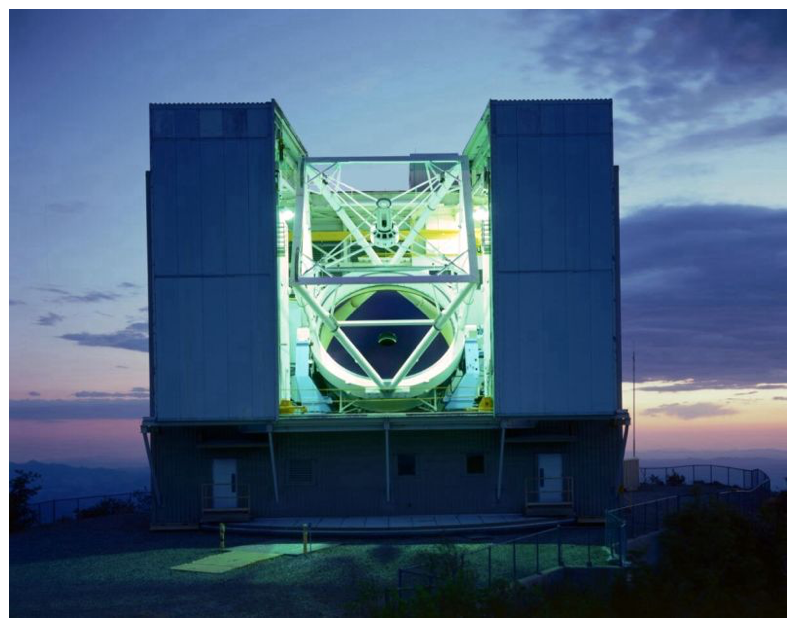 Prior to the new telescope contracts, NU astronomers did not have guaranteed access to the MMT, Keck, or any other research-grade observational facility. Now, Northwestern researchers are guaranteed an allotment of time per year to collect data. This is a significant commitment to and expansion of observational capabilities at Northwestern. CIERA will now have the ability to train students in observational astronomy with world-class facilities. Researchers will have more freedom with their projects because of the removal of the observatory time application process; guaranteed time allows researchers to take on more high-risk, high-reward projects. With access to two of the leading telescopes in the world, the observational astronomers at CIERA have the ability to thrive and conduct research in exciting new areas, connecting theoretical research to observational data. Learn more about telescope access at CIERA. |
|||||||||||||||
|
Professor Ulmer will receive funds from the National Reconnaissance Office for a project called DOMinATE (Deployable Optical MembrAne Telescope). DOMinATE is a spin-off of Ulmers NASA Innovative Advanced Concepts (NIAC) project called APERTURE, with applications to CubeSats using an innovative material for the substrate, called shape memory alloys (SMAs). A CubeSat is a type of miniaturized satellite for space research that is made up of multiples of 10×10×10 cm cubic units. Collaborators on the project come from the University of Central Florida for the SMA development and the University of Miami for CubeSat considerations. The NIAC Program nurtures visionary ideas that could transform the future of NASA missions. View an animation of the APERTURE telescope conceptual design. |
|||||||||||||||
|
In an effort to increase our cross-discipline collaborations with researchers from many institutions in fields beyond astronomy, CIERA has begun holding talks in our CIERA Interdisciplinary Colloquia series more often. On November 2, Yale Universitys Greg Laughlin presented Poincaré's Legacy: Predictions on Time Scales Ranging from Milliseconds to Billions of Years to an audience of about 75. He discussed two long-standing, and at first glance entirely unrelated, problems of prediction: (1) the long-term dynamical stability of the Solar System, and (2) price movements and volatility in financial markets. On December 1, we co-hosted Dan Tamayo with the Department of Earth and Planetary Sciences. Dan is from the Canadian Institute for Theoretical Astrophysics and presented A Million-fold Speedup in the Dynamical Characterization of Multi-planet Systems to an interdisciplinary audience of approximately 40 people. Stay tuned for more CIERA Interdisciplinary Colloquia. |
|||||||||||||||
|
On November 2, Science in Society announced the winners of the 2017 Northwestern Scientific Images Contest. The winners were announced during an exhibition launch and reception held at Evanston Township High School (ETHS). Aaron Geller, an astronomer with a joint appointment in CIERA and the Adler Planetarium, swept both 1st place and the Peoples Choice Award with his computer simulation of a dense star cluster. (The Peoples Choice Award is voted on by the students of ETHS.) Geller has participated in the contest and related outreach activities for the past few years, but this is the first time hes come in first place. Astronomy is a great entry point into science, and through engaging the public with astronomy we can share a love of science, the scientific method, and the drive to think critically about our world, said Geller. Continue to the full Science in Society article. |
October 2017
|
||||||||||||||
|
Magdalena R. Osburn, a Northwestern University geobiologist who studies ancient and modern microbes, has been awarded a 2017 Packard Fellowship for Science and Engineering from the David and Lucile Packard Foundation. The prestigious fellowship includes an unrestricted research grant of $875,000 over five years to pursue innovative and experimental research. The foundation named Osburn and 17 others as the nations most innovative, early-career scientists and engineers. These young professors are tackling some of the critical scientific questions of our time and promise to have a big impact not just on their fields but also on the students working with them. Continue to the full Northwestern News article. |
|||||||||||||||
|
At the 2017 SACNAS National Diversity in STEM Conference (October 19-21 in Salt Lake City, Utah), Research Experience for Undergraduates (REU) student José Flores won best poster presentation. His poster was titled Time Scales of Different Star Formation Rate Indicators Using FIRE Star Formation Histories. The annual SACNAS meeting is the largest multicultural and multidisciplinary STEM diversity conference in the country. SACNAS, the Society for Advancement of Chicanos/Hispanics and Native Americans in Science, is an inclusive organization dedicated to fostering the success of Chicano/Hispanic and Native American scientists, from college students to professionals, in attaining advanced degrees, careers, and positions of leadership in STEM. José is a Physics & Astronomy major and Math minor at Cal Poly Pomona. He presented research he developed during the summer of 2017 as part of the CIERA REU program, working with his advisor, Professor Claude-André Faucher-Giguère. Visit José Flores' web site. |
|||||||||||||||
|
On October 5, 2017 at 7:30pm, CIERA held its annual public lecture at Cahn auditorium. This year, we welcomed Wendy Freedman from the University of Chicagos Kavli Institute for Cosmological Physics, who presented to an audience of about 300. Her talk, The Unexpected Universe: Astronomical Telescopes Continue to Reveal New Surprises, discussed the future of telescopes and how they will revolutionize the discovery of celestial bodies throughout the universe. One telescope in particular, the Giant Magellan Telescope (GMT), is being built in the Andes Mountains in Chile. The GMT is the first telescope of its kindwith the sensitivity up to 20 million times of that of the human eye. Freedman explained how this telescope will allow astronomers to see the first light in the universe, and may have the capability of spotting life on planets outside of our solar system. Wendy Freedman initiated the GMT project and will help reveal the telescope in 2018. Read the article by the Office for Research.
|
|||||||||||||||
|
CIERA Associate Director and Research Professor Shane Larson has been named to the NASA LISA Study Team. LISA, the "Laser Interferometer Space Antenna," is a space-based detector that will be jointly flown by NASA and the European Space Agency near the end of the next decade. The NASA LISA Study Team was established by NASA HQ in October 2017 to assist the U.S. community in preparing for the 2020 astrophysics Decadal Survey and provide input to the Study Office and NASA HQ on the LISA mission. It consists of independent U.S. scientists with expertise in gravitational wave technologies, signal analysis, and astrophysics.
|
|||||||||||||||
|
The 27th Midwest Relativity Meeting was held October 12-14, 2017, at the University of Michigan in Ann Arbor. This meeting brings together researchers from across the Midwest and beyond to discuss General Relativity and a broad range of topics in gravitational physics. Astronomy graduate student Katie Breivik won the Blue Apple Prize for the best student talk, out of nearly 40 presentations. Her talk was titled, Revealing the Milky Way's black hole population with Gaia. Congratulations, Katie! |
|||||||||||||||
|
On October 16, 2017, scientists announced the first-ever observation of a binary neutron star inspiral and mergerthis astronomical event will provide a powerful new way to understand the lives of stars and how they die and join the galactic graveyard. Vicky Kalogera, CIERA Director and Daniel I. Linzer Distinguished University Professor in the Weinberg College of Arts and Sciences, served as lead astrophysicist on the panel at the National Science Foundations (NSF) press conference announcing the discovery. Anticipated by the Laser Interferometer Gravitational-Wave Observatory (LIGO) for more than 20 years, this merger represents the first joint detection of an astronomical event using two astronomical observing techniques: gravitational waves and electromagnetic radiation. Together these approaches are known as "multi-messenger astronomy". Gravitational waves were the subject of 2017's Nobel Prize in Physics, and multi-messenger astronomy was named one of the NSF's 10 Big Ideas for future scientific investment. Northwestern is currently one of the few universities in the world with expertise on both sides of this cutting-edge field.
Learn more from CIERA researcher interviews at Northwestern's LIGO Media Gallery. ROUNDUP OF MEDIA MENTIONS OF CIERA/NORTHWESTERN
|
|||||||||||||||
|
Barry Barish, Kip Thorne and Rai (Rainer) Weiss received the 2017 Nobel Prize in Physics October 3rd for decisive contributions to the LIGO detector and the observation of gravitational waves. Thorne and Weiss are previous CIERA Annual Public Lecturers. I was so much hoping for this wonderful news, said Vicky Kalogera, gravitational-wave astrophysicist and Director of CIERA at Northwestern University, who contributed to the historic detections of gravitational waves. My Northwestern colleagues and I warmly congratulate Rai, Kip and Barry on this recognition. The discovery of black-hole mergers and the detection of gravitational waves never would have happened without these creative scientists. Gravitational waves, ripples in the fabric of spacetime, were first predicted by Albert Einstein in 1916 and are a new way of observing the universe. The Laser Interferometer Gravitational-Wave Observatory (LIGO) Scientific Collaboration has detected gravitational waves four times first, on Sept. 14, 2015, and most recently, on Aug. 14, 2017. All four signals detected so far were created by colliding black holes. Moving forward, astronomers are working on methods for combining gravitational wave data and electromagnetic data to study cosmic sources. The National Science Foundation named this new technique, called multi-messenger astronomy, one of the top six ideas to pursue in the future. Multi-messenger astronomy holds the answers to untold astronomical questions, including how the universe was formed. Rai, Kip and Barry launched the LIGO project decades ago and worked very hard to confirm Einsteins theory, said Kalogera, the Linzer Distinguished University Professor in Physics and Astronomy in the Weinberg College of Arts and Sciences. I am so proud to have had the opportunity to learn from them since my years as a young researcher. Rai and Kip especially were influential in my decision to join the LIGO Scientific Collaboration at a time when most traditional astronomers were advising me against it. I have grown through their advice and support and will always be grateful for what they have achieved for science and the younger generation of scientists. A Ligo Scientific Collaboration (LSC) member for more than 15 years, Kalogera is LSCs most senior astrophysicist. She leads Northwesterns LSC group, which includes Shane L. Larson, CIERA associate director and a research associate professor of physics and astronomy at Northwestern, and Selim Shahriar, professor of electrical engineering and computer science at Northwesterns McCormick School of Engineering. Larson and Shahriar also have been mentored over the years by Weiss or Thorne. Eleven postdoctoral fellows and graduate and undergraduate students also are members of the Northwestern group. Learn more about the first gravitational-wave detections and Northwesterns role in the discoveries:
|
September 2017
|
||||||||||||||
|
The LIGO Scientific Collaboration (LSC) and the Virgo collaboration announced today (Sept. 27) the first joint detection, made on August 14, of gravitational waves with both LIGO and Virgo detectors. It is the fourth announced detection of a binary black hole system and the first significant gravitational-wave signal recorded by the Virgo detector, located near Pisa, Italy. This discovery is the first one made with three detectors -- two in the U.S. and a third across the ocean in Italy. As such, it is especially significant. This first-ever triple detection allows us to localize where the event occurred, so our research partners in observational astronomy can more accurately scan the sky to look for electromagnetic counterparts. This type of multi-messenger information will be key for solving the great cosmic puzzles. All pieces are needed, says CIERAs Director, Professor Vicky Kalogera. Shane Larson, CIERAs Associate Director, explains, Gravitational wave astronomy isn't like telescope astronomy. We've always known that our ability to map sources on the sky will get better as more detectors join the network, and Virgo has shown us what a difference it makes with a bang!" Read LIGOs news release. Continue to Shane Larsons blog post about the triple event. Additional Coverage: LIGO is funded by the NSF, and operated by Caltech and MIT, which conceived and built the project. Financial support for the Advanced LIGO project was led by NSF with Germany (Max Planck Society), the U.K. (Science and Technology Facilities Council) and Australia (Australian Research Council) making significant commitments and contributions to the project. More than 1,200 scientists from around the world participate in the effort through the LIGO Scientific Collaboration, which includes the GEO Collaboration. Additional partners are listed at http://ligo.org/partners.html. The Virgo collaboration consists of more than 280 physicists and engineers belonging to 20 different European research groups: six from Centre National de la Recherche Scientifique (CNRS) in France; eight from the Istituto Nazionale di Fisica Nucleare (INFN) in Italy; two in The Netherlands with Nikhef; the MTA Wigner RCP in Hungary; the POLGRAW group in Poland; Spain with the University of Valencia; and EGO, the laboratory hosting the Virgo detector near Pisa in Italy. Image Credit: LIGO/Virgo/NASA/Leo Singer/Axel Mellinger |
|||||||||||||||
|
In a new study published in Nature Astronomy, CIERA postdoctoral associate Giacomo Terreran discusses a highly unusual supernova. The object, called OGLE14-073, is more luminous, richer in hydrogen, slower to evolve, 10 times more energetic, and ejected more material than typical objects in its class. Interviewed by Marco Galliani for Media INAF, Terreran explains, OGLE14-073 is a unique object and we are still investigating possible exploding scenarios. When it was classified, OGLE14-073 appeared just like a boring type II supernova as hundreds are identified each year. However, it soon revealed its extraordinary character. In the future, with the advent of the next generation of telescopes, many more objects similar to OGLE14-073 will be likely discovered. We hope to be able to find them soon after explosion, with more targeted follow-up campaigns, with the aim to be able to understand what is the mechanism responsible to make explode such massive stars with such a high energy. Read Hydrogen-rich supernovae beyond the neutrino-driven core-collapse paradigm, in Nature Astronomy. |
|||||||||||||||
|
The first direct observation of merging black holes by Advanced LIGO opened a new window to our Universe. The new set of data from these detectors will provide important clues about the properties and formation of neutron stars and black holes and about the environment in which they form. But a better understanding of the processes that lead to the merger of black holes is needed in order to make sense of the large data set anticipated in the coming years. Massive stars are very social: they are often found accompanied by one or more close friends. It is not surprising therefore that the evolution of massive binary stars in the outskirts of galaxies has been suggested as the main channel for the formation of the merging black holes observed by LIGO. Massive stars are also commonly found at the center of galaxies, including the Milky Way, and dynamical processes in such environments could also cause black holes to merge. Unlike the stellar binaries in the field, the binaries in the galactic center feel strong gravitational perturbations from their neighboring stars and the super massive black holes sitting at the center. CIERA postdoctoral fellow Fabio Antonini and his colleague at the Canadian Institute for Theoretical Astrophysics, Cristobal Petrovich, have modeled the dynamics of these binaries and realized that massive stars will quite often undergo a chaotic dance that ends with a merger by gravitational wave radiation. Surprisingly, this chaotic dance is effective enough that it can explain a significant fraction of the LIGO observations. This suggests that the galactic nuclei are privileged places in the galaxies for stellar mass black holes to merge. Read the blog post by Cristobal Petrovich about the project. |
|||||||||||||||
|
At the LSC-Virgo September Meeting near Geneva, Switzerland, graduate student Eve Chase won the best poster award in the Data Analysis/Theory category. The meeting took place August 28 - September 1, 2017 at CERN, the European Organization for Nuclear Research. The LIGO Scientific Collaboration (LSC) is a collaboration of international physics institutes and research groups dedicated to the search for gravitational waves. Virgo is an interferometer gravitational wave detector in Pisa, Italy. Eve is a second-year astronomy graduate student who is part of Vicky Kalogeras group. Eve studies computational and data analysis techniques related to gravitational wave astronomy. Her poster, titled "Gravitational-Wave Localization in the LSST Era, focused on using the Large Synoptic Survey Telescope to search for electromagnetic counterparts to gravitational waves. Eve took home 150 Swiss Francs as her prize. Co-authors on Eves project include Sam Imperato and Monica Rizzo (along with Chris Pankow, Scott Coughlin and Vicky Kalogera, all from Northwestern). Sam is a high school student who contributed heavily to tracking improvements to GW source localization as additional detectors are commissioned. Monica Rizzo is a Research Experience for Undergraduates (REU) student from the Rochester Institute of Technology. She spent her summer modeling expected light curves from gravitational-wave counterparts, such as kilonovae. Congratulations, Eve! |
|||||||||||||||
|
The September 2017 issue of Sky & Telescope magazine features an article by Vicky Kalogera which gives her personal and professional account of the first gravitational wave events detected by LIGO. In the article, Prof.Kalogera describes the science behind the detections, their significance and promise, as well as the excitement in the astronomy community as these phenomenal occurrences unfolded. Access the September 2017 issue. 
|
|||||||||||||||
|
Northwestern University is in the midst of an astrophysics faculty expansion plan. With last years arrival of Raffaella Margutti, an expert in 'transient phenomena' such as supernovae and gamma ray bursts, Northwestern became one of the very few universities in the nation with both a LIGO research group and a transient astronomy team. This fall, we are excited to announce two new astrophysics faculty additions at CIERA: Wen-fai Fong and Sasha Tchekhovskoy. Wen-fai's research focuses on mergers of compact objects and their environments; she chases the elusive electromagnetic counterparts to gravitational-wave sources. She will be a Hubble Postdoctoral Fellow for her first year at Northwestern, before moving into her faculty role. A former NASA Einstein Fellow, Sasha will start as an assistant professor this fall. His interests include high-energy astrophysics processes powered by compact objects, black holes, and neutron stars which he simulates using high-performance computing. Welcome, Wen-fai and Sasha! |
|||||||||||||||
|
We are pleased to announce our new Director of Operations, Dr. Kari Frank. Kari holds a PhD in Physics from Purdue, and is formerly a Research Associate at Penn State. Karis focus is X-ray observations of galaxy clusters and supernova remnants. In addition to her research, Kari has devoted time at both Purdue and Penn State to help improve the careers of graduate students and postdocs. Welcome, Kari! With Karis arrival, we wish farewell to John Everett, who served extremely capably for the past 5 years as Assistant Director and then Director of Operations for CIERA. John has taken an exciting professional opportunity in the Denver Public Schools and has moved west to pursue this, as well as to be closer to his family. We thank John and wish him all the best! As of September 1st, Prof. Shane Larson will take on the new role of Associate Director of CIERA as half-time of his full-time position at Northwestern (transitioning from a joint position between Northwestern and the Adler Planetarium). As Associate Director (part-time), Shane will take on CIERA's growing responsibilities in the areas of public outreach, science communication, and development efforts, engaging with Northwestern Alumni and CIERA Friends. |
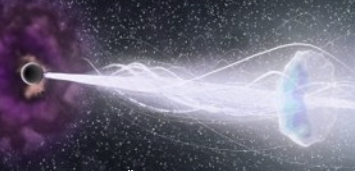

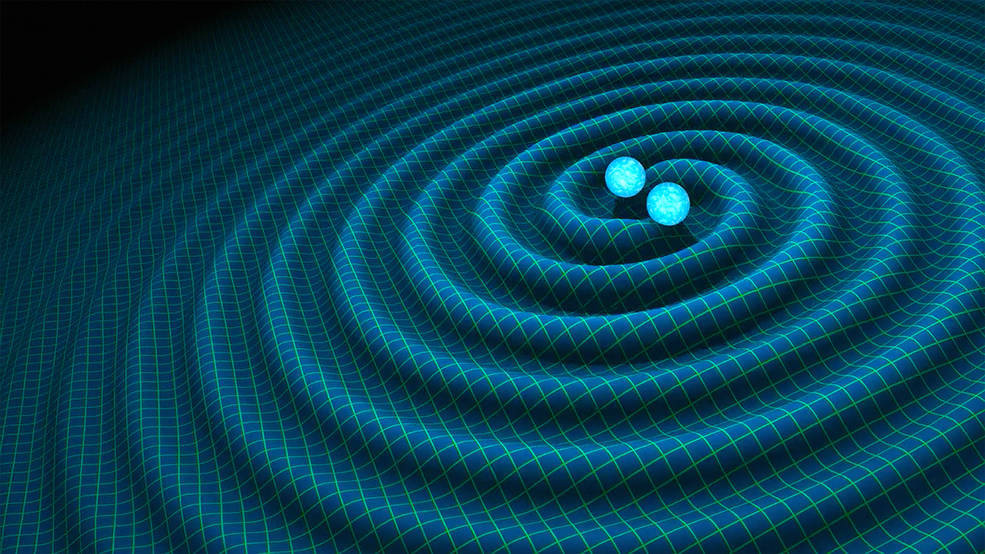
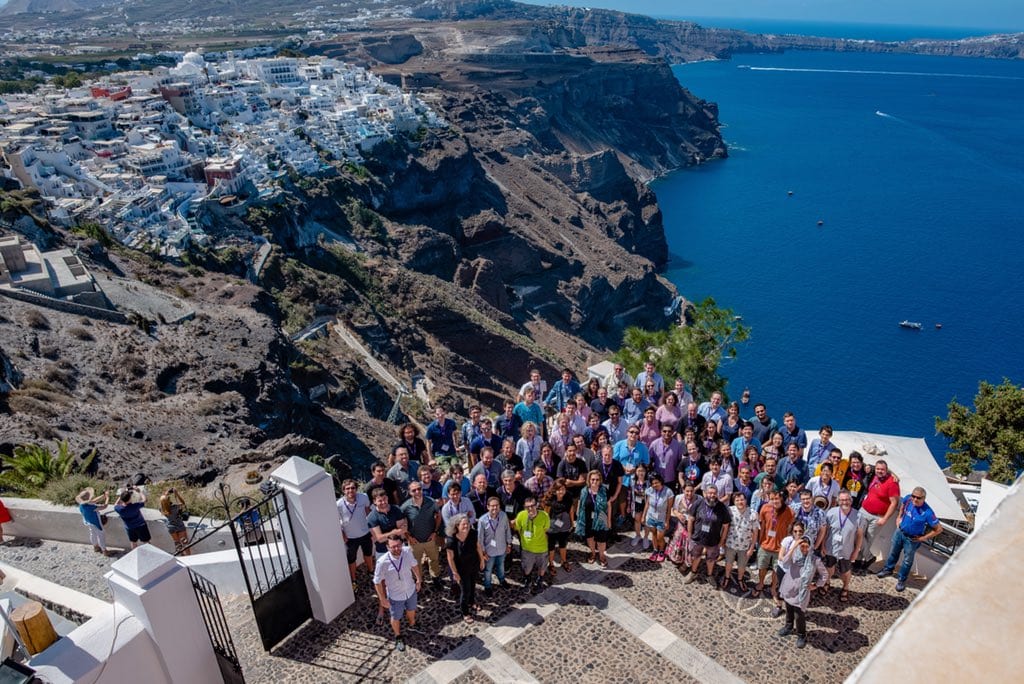
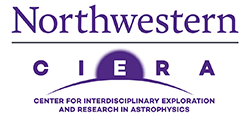
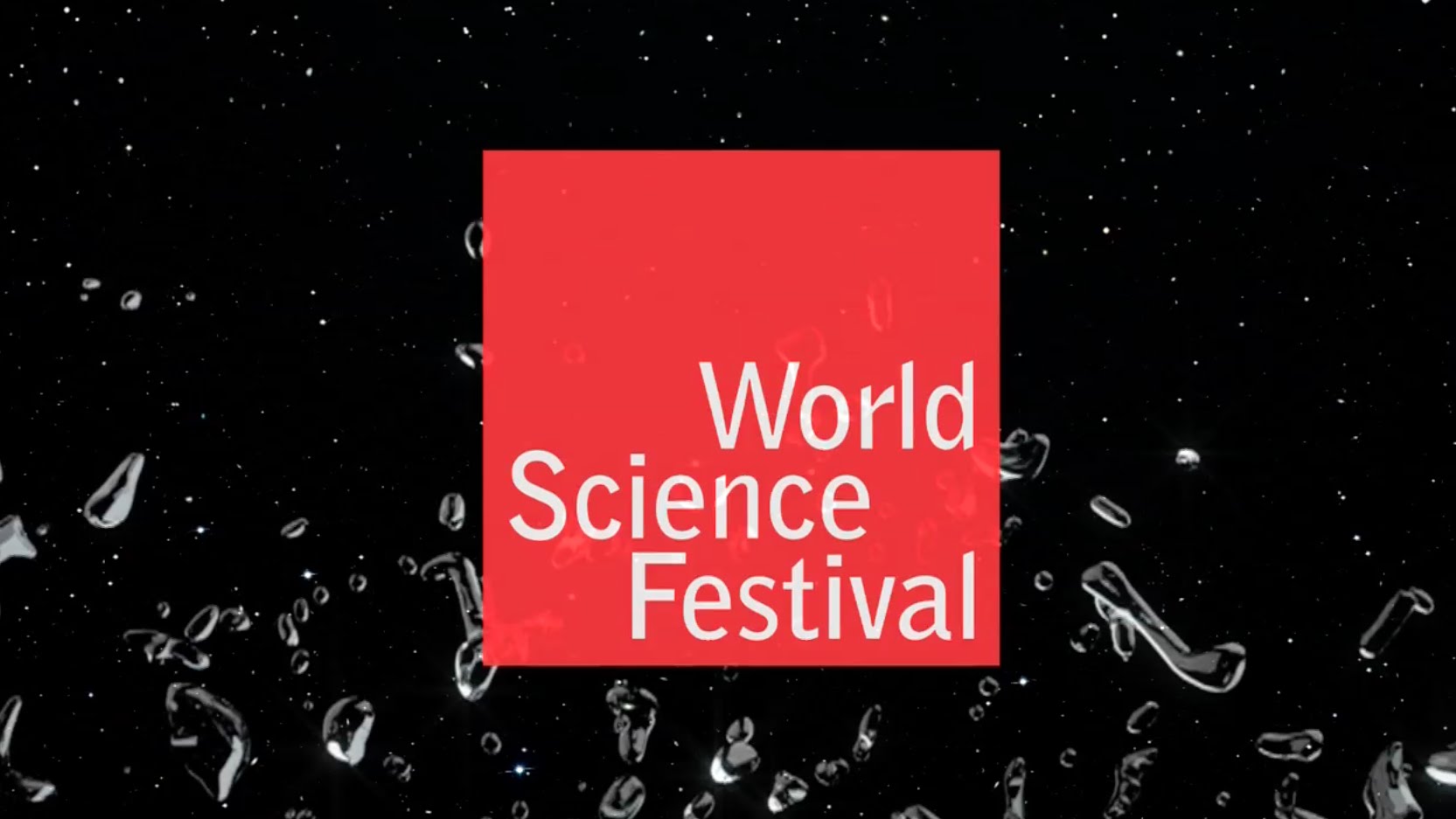
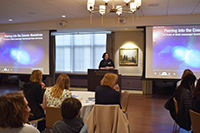
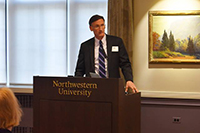
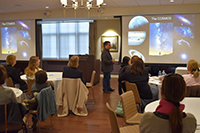
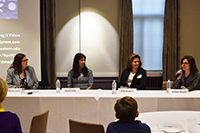
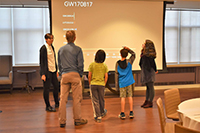
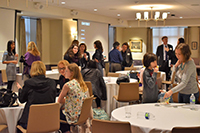
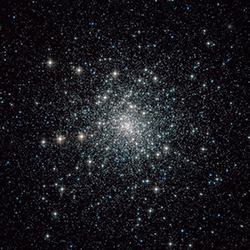

 Kate Alexander (Harvard University) will join as NASA Einstein Fellow to work on astronomical transients and the properties of their outflows, using radio observations and observations across the electromagnetic spectrum.
Kate Alexander (Harvard University) will join as NASA Einstein Fellow to work on astronomical transients and the properties of their outflows, using radio observations and observations across the electromagnetic spectrum. Ian Christie (Purdue University)will join as CIERA postdoctoral associate to work with Prof. Tchekhovskoy on the theory and simulation of black hole accretion and outflows in a wide range of astrophysical contexts.
Ian Christie (Purdue University)will join as CIERA postdoctoral associate to work with Prof. Tchekhovskoy on the theory and simulation of black hole accretion and outflows in a wide range of astrophysical contexts. Erin Cox (U. of Illinois, Urbana-Champaign) will join as CIERA postdoctoral associate to work with Prof. Novak to study the formation of stars and planets. She brings her expertise in ALMA observations of planet-forming disks and will contribute to balloon-borne polarimetry work.
Erin Cox (U. of Illinois, Urbana-Champaign) will join as CIERA postdoctoral associate to work with Prof. Novak to study the formation of stars and planets. She brings her expertise in ALMA observations of planet-forming disks and will contribute to balloon-borne polarimetry work. Luke Zoltan Kelley (Harvard University) will join as CIERA Fellow to work on modeling gravitational wave and electromagnetic signals from a variety of astrophysical sources, including predictions for gravitational waves produced by supermassive black holes and detectable by pulsar timing arrays.
Luke Zoltan Kelley (Harvard University) will join as CIERA Fellow to work on modeling gravitational wave and electromagnetic signals from a variety of astrophysical sources, including predictions for gravitational waves produced by supermassive black holes and detectable by pulsar timing arrays. Emily Leiner (U. Madison-Wisconsin) will join as an NSF Astronomy & Astrophysics Fellow to work on studies of exotic stars born through mass transfer and mergers within star clusters, using both observations and numerical simulations.
Emily Leiner (U. Madison-Wisconsin) will join as an NSF Astronomy & Astrophysics Fellow to work on studies of exotic stars born through mass transfer and mergers within star clusters, using both observations and numerical simulations. Mario Spera (University of Innsbruck) will join as a Marie Curie Fellow to work on theoretical studies of binary star evolution and the dynamics of dense star clusters.
Mario Spera (University of Innsbruck) will join as a Marie Curie Fellow to work on theoretical studies of binary star evolution and the dynamics of dense star clusters.

